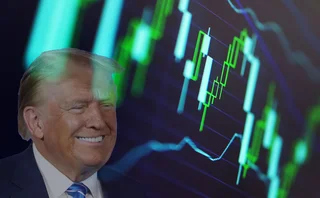
A positive response to negative oil prices
Overhauling pricing models could reap rewards even if prices don’t cross zero again
Responding to extreme events is never easy. No one wants to waste resources over-preparing for something that may never occur again. But equally, no one wants to be caught out a second time.
This is the conundrum facing the oil market in the wake of futures prices turning negative – a once-unthinkable phenomenon that caused chaos in April. For options traders and quants an important consideration is whether to continue using the Black-Scholes options pricing model – which cannot accept negative prices – or switch to an alternative model, with all the upheaval and operational risk that would cause. CME and Ice made the decision in April to immediately switch to the Bachelier model for options pricing.
Six weeks later, the collapse of CME crude futures to -$40 a barrel looks more and more like an aberration – the confluence of a series of never-to-be-repeated events. Some quants have already taken the data out of their models, treating them as outliers.
A return to negative prices seems unlikely anytime soon. Oil demand is picking up and production cuts are already eating into the supply overhang. Options traders that stuck with Black-Scholes may see little reason to change now.
But even without negative oil prices, there are good reasons to at least consider the Bachelier model for pricing options. Those familiar with it say the 120-year old model has some advantages over Black-Scholes for pricing certain contracts. For maturities of up to three or four months out, there is evidence that the Bachelier volatility smile fits the oil market better than Black-Scholes.
Even if they do not use it themselves, traders cannot ignore the wider adoption of Bachelier by exchanges and other market participants. While the models are mathematically similar, there are some key differences that must be factored in when pricing and margining contracts. In general, Bachelier assigns higher values to out-of-the-money puts than Black-Scholes, while out-of-the-money calls are priced lower. As prices move closer to zero, the differences between the models become more pronounced.
Another oil price shock cannot be discounted entirely. These are strange times and circumstances can change very quickly. A second wave of Covid-19 is entirely possible and could mean the return of the global lockdowns that caused oil demand to drop so precipitously in the first place.
The US Commodity Futures Trading Commission issued an advisory on May 13 reminding firms they are “expected to prepare for the possibility that certain contracts may continue to experience extreme market volatility, low liquidity and possibly negative pricing”.
Anyone caught out by negative prices a second time is going to have some explaining to do. But reviewing and overhauling pricing models after a market-changing event is more than just a compliance exercise. It’s prudent risk management. And incorporating Bachelier into pricing may have benefits even if negative oil prices turn out to be a one-off.
Only users who have a paid subscription or are part of a corporate subscription are able to print or copy content.
To access these options, along with all other subscription benefits, please contact info@risk.net or view our subscription options here: http://subscriptions.risk.net/subscribe
You are currently unable to print this content. Please contact info@risk.net to find out more.
You are currently unable to copy this content. Please contact info@risk.net to find out more.
Copyright Infopro Digital Limited. All rights reserved.
As outlined in our terms and conditions, https://www.infopro-digital.com/terms-and-conditions/subscriptions/ (point 2.4), printing is limited to a single copy.
If you would like to purchase additional rights please email info@risk.net
Copyright Infopro Digital Limited. All rights reserved.
You may share this content using our article tools. As outlined in our terms and conditions, https://www.infopro-digital.com/terms-and-conditions/subscriptions/ (clause 2.4), an Authorised User may only make one copy of the materials for their own personal use. You must also comply with the restrictions in clause 2.5.
If you would like to purchase additional rights please email info@risk.net
More on Our take
Why a Trumpian world could be good for trend
Trump’s U-turns have hit returns, but the forces that put him in office could revive the investment strategy
Roll over, SRTs: Regulators fret over capital relief trades
Banks will have to balance the appeal of capital relief against the risk of a market shutdown
Thrown under the Omnibus: will GAR survive EU’s green rollback?
Green finance metric in limbo after suspension sees 90% of top EU banks forgo reporting
Has the Collins Amendment reached its endgame?
Scott Bessent wants to end the dual capital stack. How that would work in practice remains unclear
Talking Heads 2025: Who will buy Trump’s big, beautiful bonds?
Treasury issuance and hedge fund risks vex macro heavyweights
The AI explainability barrier is lowering
Improved and accessible tools can quickly make sense of complex models
Do BIS volumes soar past the trend?
FX market ADV has surged to $9.6 trillion in the latest triennial survey, but are these figures representative?
DFAST monoculture is its own test
Drop in frequency and scope of stress test disclosures makes it hard to monitor bank mimicry of Fed models








